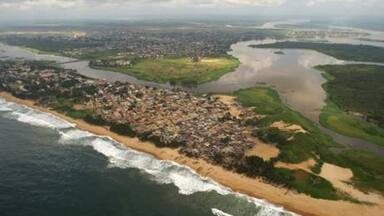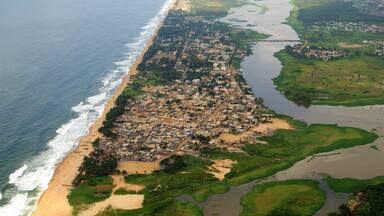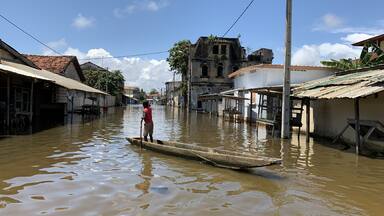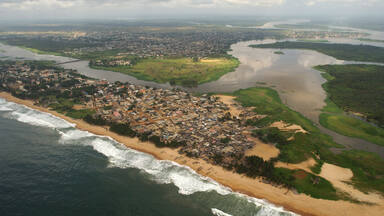Historic Town of Grand-Bassam
Historic Town of Grand-Bassam
The first capital of Côte d’Ivoire, the Historic Town of Grand-Bassam, is an example of a late 19th- and early 20th-century colonial town planned with quarters specializing in commerce, administration, housing for Europeans and for Africans. The site includes the N’zima African fishing village alongside colonial architecture marked by functional houses with galleries, verandas and gardens. Grand-Bassam was the most important port, economic and judicial centre of Côte d’Ivoire. It bears witness to the complex social relations between Europeans and Africans, and to the subsequent independence movement. As a vibrant centre of the territory of French trading posts in the Gulf of Guinea, which preceded modern Côte d’Ivoire, it attracted populations from all parts of Africa, Europe and the Mediterranean Levant.
Description is available under license CC-BY-SA IGO 3.0
Ville historique de Grand-Bassam
Première capitale de Côte d’Ivoire, la ville de Grand-Bassam est un exemple urbain colonial de la fin du xixe siècle et de la première partie du xxe siècle. Elle suit une planification par quartiers spécialisés dans le commerce, l’administration, l’habitat européen et l’habitat autochtone. Le site comprend également le village de pêcheurs africain de N’zima et des exemples d’architecture coloniale comme des maisons fonctionnelles dotées de galeries, de vérandas et de nombreux jardins. Grand-Bassam fut la capitale portuaire, économique et juridique de la Côte d’Ivoire ; elle témoigne des relations sociales complexes entre les Européens et les Africains puis du mouvement en faveur de l’indépendance. La ville, véritable poumon économique du territoire des comptoirs français du golfe de Guinée – qui a précédé la Côte d’Ivoire moderne – a attiré des populations venant de toutes les contrées d’Afrique, d’Europe et du Levant méditerranéen.
Description is available under license CC-BY-SA IGO 3.0
Grand-Bassam
Primera capital colonial de Côte d’Ivoire, es un ejemplo de ciudad colonial de finales del siglo XIX y principios del XX con una planificación que incluye barrios especializados en el comercio, la administración, la vivienda para europeos y la vivienda para africanos. El sitio incluye el pueblo de pescadores africanos de N’zima, y ejemplos de arquitectura colonial marcada por viviendas funcionales con galerías y jardines numerosos. Grand-Bassam fue el puerto más importante así como el centro legal de Côte d’Ivoire. Es también testimonio de las complejas relaciones sociales entre europeos y africanos y de los movimientos de independencia en que éstas desembocaron. Además, fue el principal nudo del comercio francés en el Golfo de Guinea que precedió a la actual Côte d’Ivoire y atrajo poblaciones de todas las zonas de África, de Europa y del Levante mediterréaneo.
source: UNESCO/CPE
Description is available under license CC-BY-SA IGO 3.0
グラン・バッサム歴史都市
source: NFUAJ
Historische stad Grand-Bassam
Source: unesco.nl
Outstanding Universal Value
Brief synthesis
The historic town of Grand-Bassam is an example of a colonial town built at the end of the 19th century and during the early 20th century. It follows a planning concept based on the specialisation of quarters for commerce, administration, housing for Europeans and housing for Africans. It embodies, on the one hand, colonial architecture and town planning, based on the principles of functionalism and hygiene of the time, and adapted to climatic conditions, and, on the other hand, an village N’zima which demonstrates the permanency of indigenous cultures. Grand-Bassam was the first colonial capital, and the most important port, economic centre and legal centre of Côte d’Ivoire; it bears witness to the complex social relations between Europeans and Africans, and then to the popular movement in favour of independence.
Criterion (iii): Grand-Bassam bears witness, through its well preserved urban organisation, to an important cultural tradition linked to its role as a colonial capital, an administrative centre for the former AOF (Afrique occidentale française) and a regional commercial hub. From the 1880s to the 1950s, the town brought together various African, European and Middle Eastern populations. Cohabitation between them was harmonious but at the same time conflictual.
Criterion (iv): Grand-Bassam constitutes an outstanding example of rational colonial town planning, with its specialised quarters in an overall urban network in which vegetation has an important role. The colonial architecture is characterised by a sober and functional style, using principles of hygiene adapted to a tropical location. The organisation of the vernacular house in the N'zima village echoes this approach, expressing the permanency of indigenous values.
Integrity
The integrity of the urban fabric is generally good. The property includes sufficiently large ensembles of characteristic built structures to enable them to be well understood. However, the architectural integrity of the buildings is under threat in many cases, because of abandonment and lack of maintenance. The integrity of the urban landscape might be under threat from the pressure for property linked to beach tourism.
Authenticity
The authenticity of the urban fabric has been generally conserved, enabling satisfactory expression of the Outstanding Universal Value of the property. While some buildings, which are generally the public ones, have been acceptably restored and reused, the architectural integrity of a large number of buildings is often mediocre or poor, and their authenticity has in some cases been adversely affected by alterations which are not in keeping with the original design.
Protection and management requirements
Protection of the property and its management system are appropriate and their implementation is under way, including through the establishment of the Cultural Heritage Centre and through the overarching Building Permits Commission. However, it is essential to confirm the suspensive effect of decisions of the latter and strengthen the human and financial resources dedicated to the conservation of the property. The boundaries of the unified buffer zone should be extended around the Petit Paris embankment and the lighthouse as in the original nomination dossier.













